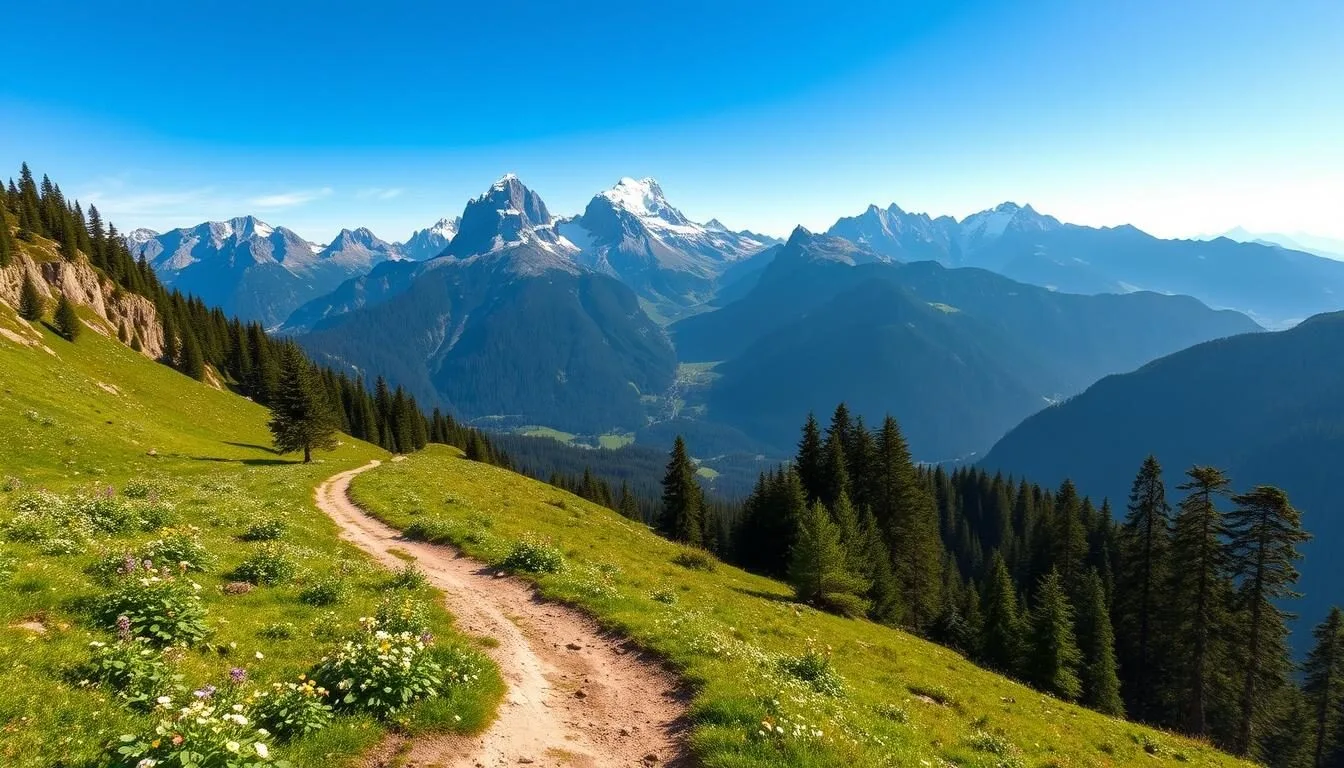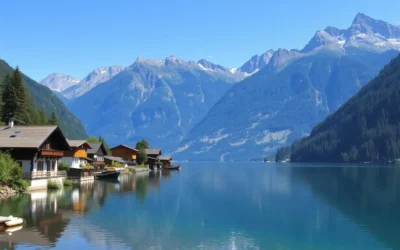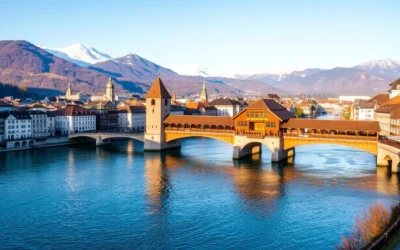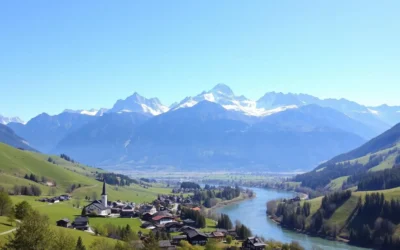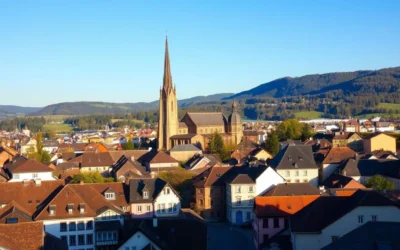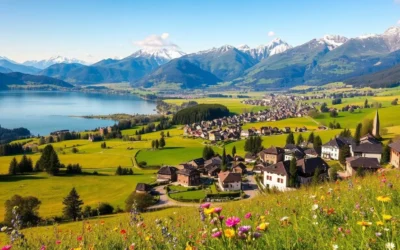✓ Accommodations✓ Flights✓ Rental Cars
Standing tall at 4,545 meters, Dom is the third-highest mountain in Europe and a breathtaking destination in the Swiss Alps. Located in the Mischabel massif, this majestic peak offers unparalleled views and adventurous experiences for travelers.
As you plan your tour to this incredible region, you’ll find that Dom is a haven for nature lovers and adventure seekers alike. Our comprehensive guide will walk you through the top experiences and activities to make the most of your time in this mountain paradise.
From challenging hiking trails to panoramic viewpoints, you’ll have a wealth of options to create unforgettable experiences amidst the beauty of the Swiss Alps.
Discovering Dom: Switzerland’s Majestic Alpine Peak
As one of the most impressive peaks in the Swiss Alps, Dom offers breathtaking views and a glimpse into the region’s geological history. You are about to embark on a journey to discover the majesty of Dom, a mountain that has captivated adventurers and locals alike for centuries.
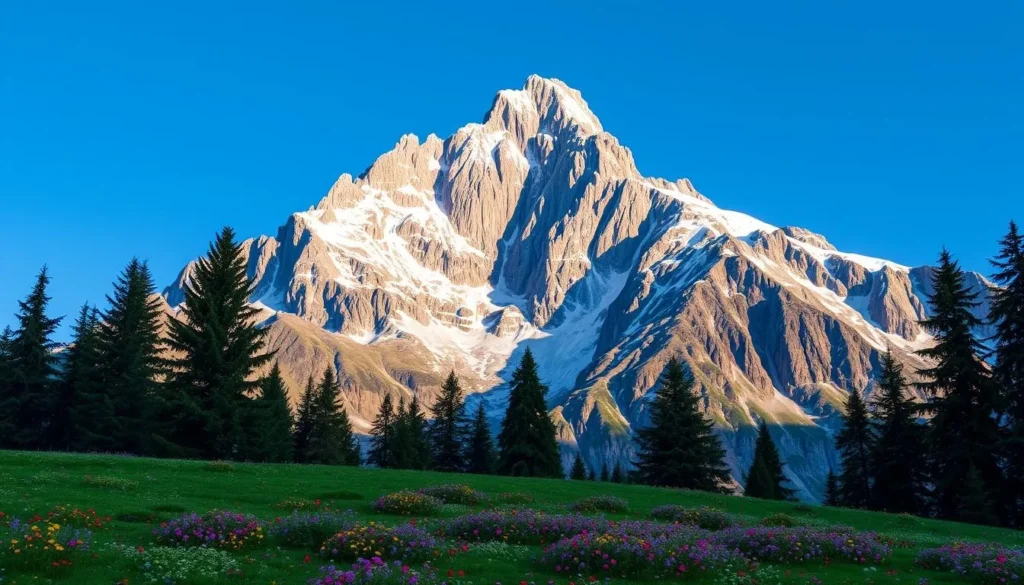
The Geological Marvel of Dom
Dom stands as a geological marvel in the Swiss Alps, part of the impressive Mischabel massif that dominates the skyline between the Matterhorn and Monte Rosa. The mountain’s formation dates back millions of years, created through the collision of the African and Eurasian tectonic plates that formed the Alps. This process has resulted in a landscape of striking beauty, with Dom being one of its crown jewels.
The geological significance of Dom is further highlighted by its unique flora. Despite being one of the coldest places in Europe, Dom is home to remarkable alpine flora, including a rare purple saxifrage that survives despite nightly freezing temperatures. This hardy species thrives on the Dom’s summit, a testament to the mountain’s diverse and resilient ecosystem.
Historical Significance of Dom in Swiss Culture
Throughout history, Dom has held a special place in Swiss culture, symbolizing the nation’s connection to its alpine heritage and the mountaineering tradition that has shaped local identity. The mountain’s name has interesting origins, possibly derived from the Latin “domus” meaning house or dome, referring to its distinctive summit shape that has been a landmark for generations of Swiss people.
Local folklore and traditions surrounding Dom reflect the deep respect Swiss culture has for the mountains that have both protected and challenged its people throughout history. You can experience this rich cultural heritage by exploring the local customs and stories that revolve around Dom, offering a unique insight into the heart of Swiss culture.
Planning Your Visit to Dom, Switzerland
Dom, Switzerland, is a year-round destination, but the key to a successful trip lies in choosing the right time to visit. With its diverse range of activities and breathtaking landscapes, planning your tour to Dom requires careful consideration of several factors, including the best time to visit, how to get there, and where to stay.
Best Time to Visit Dom
The best time to visit Dom depends on your preferred activities. Summer (June to September) offers ideal hiking conditions with alpine meadows in bloom, while winter (December to March) transforms the region into a world-class skiing destination. During your trip, you can enjoy the scenic views and pleasant weather in the summer or experience the thrill of skiing in the winter.
Spring and fall shoulder seasons provide fewer crowds and special charm, with May featuring blooming wildflowers and October showcasing spectacular fall foliage. Though some facilities may have limited operations during these times, they are great options if you’re looking for a more relaxed tour.
Getting to Dom: Transportation Options
Reaching Dom typically involves first traveling to Saas-Fee, the historic town and ski resort that serves as the gateway to the mountain. You can get to Saas-Fee by taking a train to Visp followed by a bus connection. If you’re planning a multi-day trip, consider purchasing a Swiss Travel Pass, which offers unlimited travel on the Swiss Travel System network and can be a cost-effective option for exploring the region.
When planning your day trips around Dom, allow extra time for weather changes, which can affect mountain activities and transportation schedules in this alpine environment.
Accommodation Choices Near Dom
Accommodation options range from luxury hotels in Saas-Fee with mountain views to cozy alpine lodges and budget-friendly hostels. Advance booking is strongly recommended during peak summer and winter seasons to ensure availability.
Choosing the right accommodation can enhance your travel experience, providing you with comfortable lodging and easy access to the mountain’s attractions.
Hiking Adventures on Dom Mountain
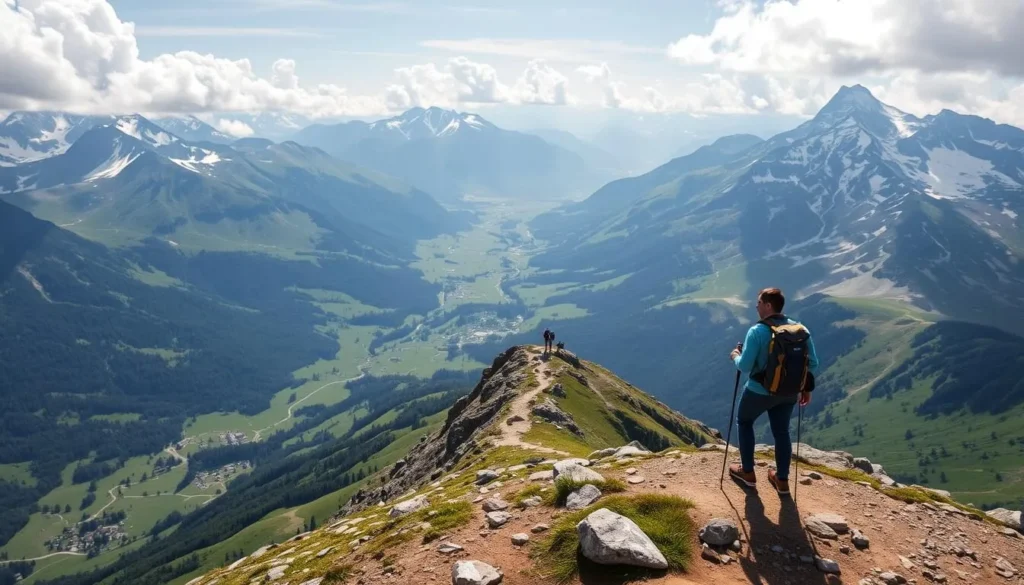
Dom Mountain beckons outdoor enthusiasts to explore its rugged trails and take in the awe-inspiring views. The Swiss Alps offer a hiker’s paradise, and Dom Mountain is a crown jewel in this breathtaking landscape. Whether you’re a beginner or an experienced hiker, Dom Mountain has something to offer.
Popular Hiking Trails for Beginners
For those new to hiking, Dom Mountain offers several beginner-friendly trails. The Saas-Fee Glacier Trail is perfect for novice hikers, offering well-marked paths with gradual elevation gain and spectacular views of Dom and surrounding mountains along the way. This trail provides an accessible experience to enjoy the stunning alpine scenery without requiring technical climbing skills.
Challenging Routes for Experienced Hikers
For seasoned adventurers, the Dom Traverse presents one of the most rewarding high-altitude routes in the Swiss Alps. This challenging hike requires proper acclimatization and technical skills, making it an exciting adventure for those looking for a rigorous experience. The sense of accomplishment and the panoramic views from the top make it a truly unforgettable experience.
Essential Gear for Dom Mountain Hikes
Regardless of the trail you choose, it’s crucial to be well-prepared. Essential gear for any Dom Mountain hike includes sturdy hiking boots with ankle support, layered clothing for rapidly changing mountain weather, sun protection, and a minimum of 2 liters of water per person. A detailed topographic map, compass or GPS device, first aid kit, and emergency whistle should also be in every hiker’s backpack.
When hiking in the Dom region, an early morning start is crucial – not only for better weather conditions but also to experience the magical alpenglow on the surrounding peaks as the first light touches the mountains. This thoughtful preparation will ensure a safe and enjoyable hiking experience on Dom Mountain’s diverse trails.
Exploring Saas-Fee: Gateway to Dom
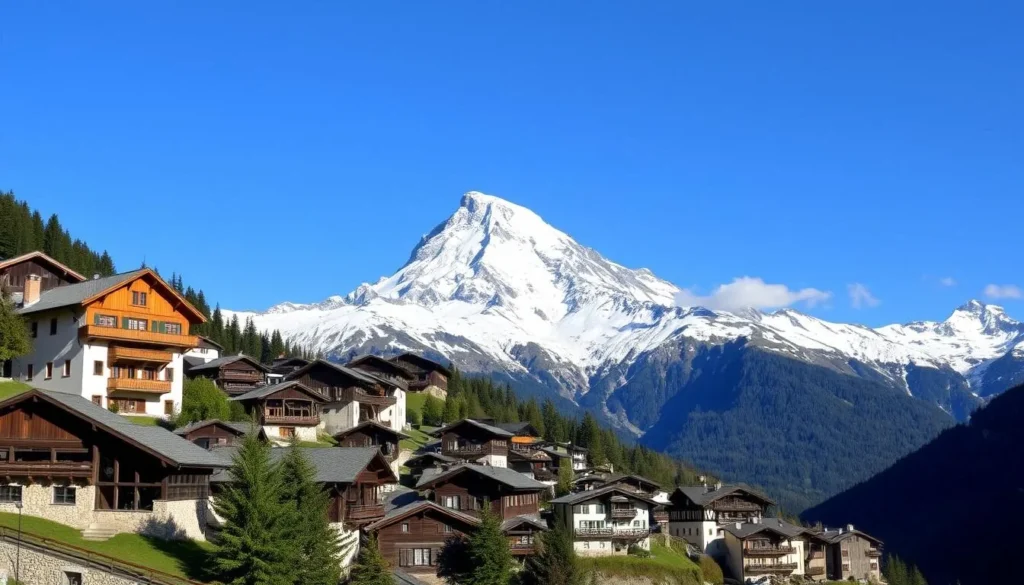
Saas-Fee, a picturesque village in the Swiss Alps, serves as the perfect gateway to exploring Dom. Often referred to as the “Pearl of the Alps,” Saas-Fee is renowned for its car-free village center, which creates a peaceful atmosphere that preserves its historic alpine charm.
Historic Attractions in Saas-Fee
The village’s rich history dates back to the 13th century. Visitors can explore the Saaser Museum, which offers fascinating exhibits on the area’s transformation from a farming community to a world-renowned mountain resort. The baroque-style parish church is another significant historic landmark worth visiting.
Dining and Shopping in Saas-Fee
Saas-Fee offers a range of culinary experiences, from traditional Swiss restaurants serving authentic raclette and fondue to modern establishments offering innovative alpine cuisine using local ingredients. The village’s shopping scene features boutiques selling handcrafted Swiss souvenirs, high-quality outdoor gear, and local specialties like mountain herbs, cheeses, and chocolates.
You can enjoy a meal at one of the many restaurants, savoring local flavors in a cozy atmosphere. Shopping in Saas-Fee is a delight, with numerous stores offering unique products that reflect the region’s culture and heritage.
Cultural Experiences in the Alpine Village
Saas-Fee provides numerous opportunities for cultural immersion. Visitors can attend local festivals that celebrate alpine traditions, engage with local artisans who continue centuries-old crafts, and experience the relaxed pace of life in this alpine village. The village’s history and culture are palpable as you stroll through its charming streets, making it an ideal place to unwind after exploring Dom.
By staying in Saas-Fee, you can fully immerse yourself in the authentic Swiss mountain culture and enjoy a range of experiences that showcase the region’s unique heritage.
Dom, Switzerland: Best Things to Do – Top Picks
When visiting Dom, Switzerland, you’ll discover a plethora of exciting activities that cater to all kinds of adventurers. The region offers a mix of challenging hikes, breathtaking views, and opportunities to explore the rich history and wildlife of the area.
The Dom mountain, being one of the highest peaks in the Swiss Alps, provides a unique experience for visitors. Whether you’re a seasoned mountaineer or just looking for a leisurely stroll, there’s something for everyone in this beautiful region.
Summiting Dom: The Ultimate Alpine Challenge
For serious mountaineers, summiting Dom represents the ultimate alpine challenge. This feat requires technical climbing skills, proper acclimatization, and typically, the guidance of a professional mountain guide to ensure a safe experience. The classic route to Dom’s summit is a 2-3 day journey, with an overnight stay at the Dom Hut (2,940m), offering an authentic high-alpine experience and stunning sunrise views across the surrounding peaks.
The climb is not for the faint of heart, but the sense of accomplishment and the breathtaking views from the top make it an unforgettable experience. As you ascend, you’ll be surrounded by the majestic beauty of the Swiss Alps, with the snow-capped peaks stretching as far as the eye can see.
Photography Hotspots Around Dom
Photography enthusiasts will find endless inspiration around Dom. The Mattmark reservoir is a perfect spot for capturing reflections of the mountain on calm mornings. The Hohsaas viewing platform offers panoramic vistas without requiring technical climbing, making it accessible to all visitors.
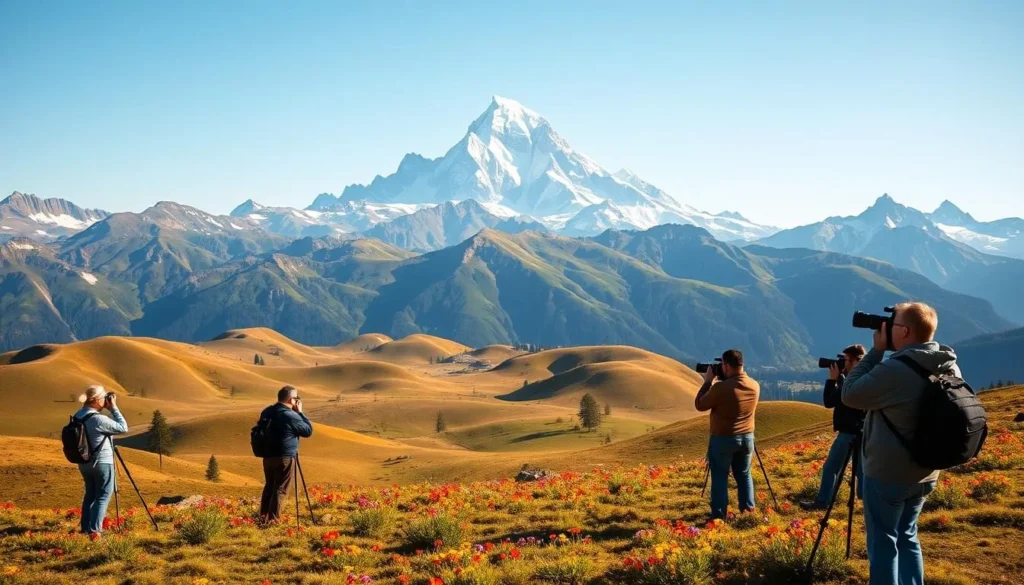
The area around Dom is dotted with picturesque villages, serene lakes, and lush green valleys, providing a myriad of opportunities to capture the beauty of the Swiss Alps. Whether you’re shooting during the golden hour or in the bright sunlight, the scenery around Dom is sure to yield some stunning photographs.
Wildlife Spotting in the Mischabel Range
The Mischabel Range, where Dom is located, is home to a diverse range of wildlife. Ibex, chamois, marmots, and golden eagles can often be observed during early morning or late afternoon hikes. The region’s unique ecosystem supports a wide variety of flora and fauna, making it a fascinating place for nature lovers.
As you explore the trails around Dom, keep an eye out for the local wildlife. The area is also steeped in history, with remnants of World War I border fortifications and historical sites that tell the story of this mountain region’s strategic importance.
For those seeking adventure without the technical climb, the Glacier Paradise experience provides access to Europe’s highest adventure park, complete with thrilling suspension bridges and viewing platforms overlooking Dom and its neighboring peaks.
Winter Activities in the Dom Region
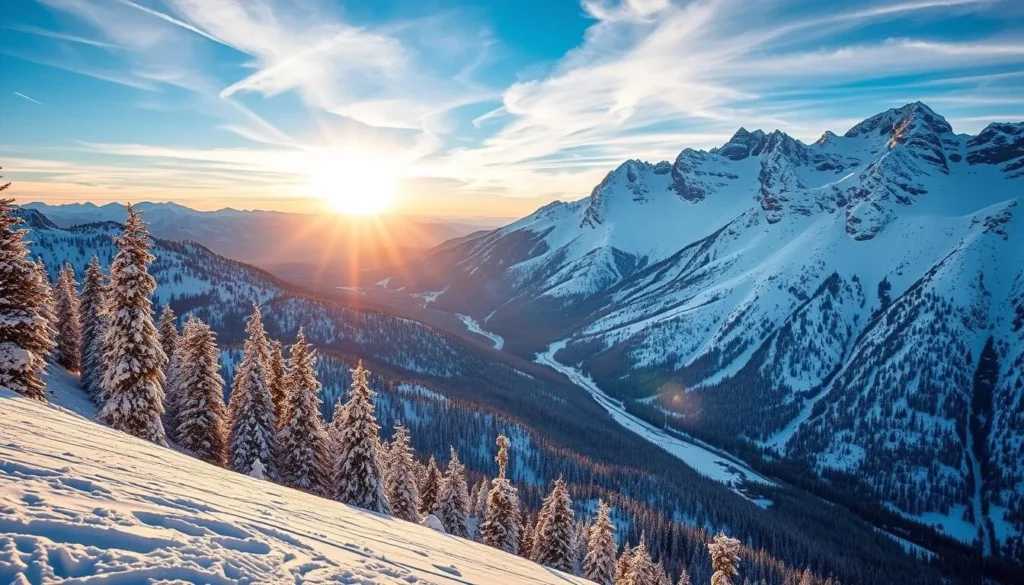
Winter in the Dom region is a time for excitement and tranquility, as the snow-covered peaks beckon visitors to explore. As you venture into this winter wonderland, you’ll discover a plethora of activities designed to satisfy both the adventurous and those seeking serene landscapes.
Skiing and Snowboarding Options
The Dom region transforms into a winter wonderland from December through April, offering world-class skiing and snowboarding across more than 100 kilometers of perfectly groomed pistes suitable for all skill levels. You can experience the thrill of downhill skiing or enjoy the serene beauty of snow-covered landscapes. Saas-Fee’s high-altitude glacier area provides reliable snow conditions throughout the winter season and even offers summer skiing opportunities, making it one of the most dependable winter sports destinations in the Alps.
For those looking for a guided tour experience, local guides are available to share their knowledge of the best slopes and snow conditions, ensuring a memorable time on the mountains.
Winter Hiking and Snowshoeing Trails
Beyond downhill sports, the area features well-marked winter hiking paths and snowshoe trails that allow you to experience the serene beauty of snow-covered alpine landscapes at a more relaxed pace. Guided snowshoe tours are available for those new to the activity, with experienced local guides sharing their knowledge of winter ecology, avalanche safety, and the region’s natural history along the way.
As you traverse these trails, you’ll have the opportunity to take in the breathtaking views of the surrounding mountains and valleys, making for an unforgettable adventure in the Dom region.
Après-Ski Experiences in the Area
After an active day on the slopes or trails, the region’s après-ski scene offers everything from lively mountain huts with traditional music to sophisticated wine bars serving local Swiss vintages. You can unwind and relive the highlights of your day in a warm and welcoming atmosphere, making the most of your time in the Dom region.
Whether you’re looking to relax or continue the excitement, the après-ski experiences in the Dom region are sure to leave a lasting impression, making your winter visit truly special.
Cable Car Experiences with Views of Dom
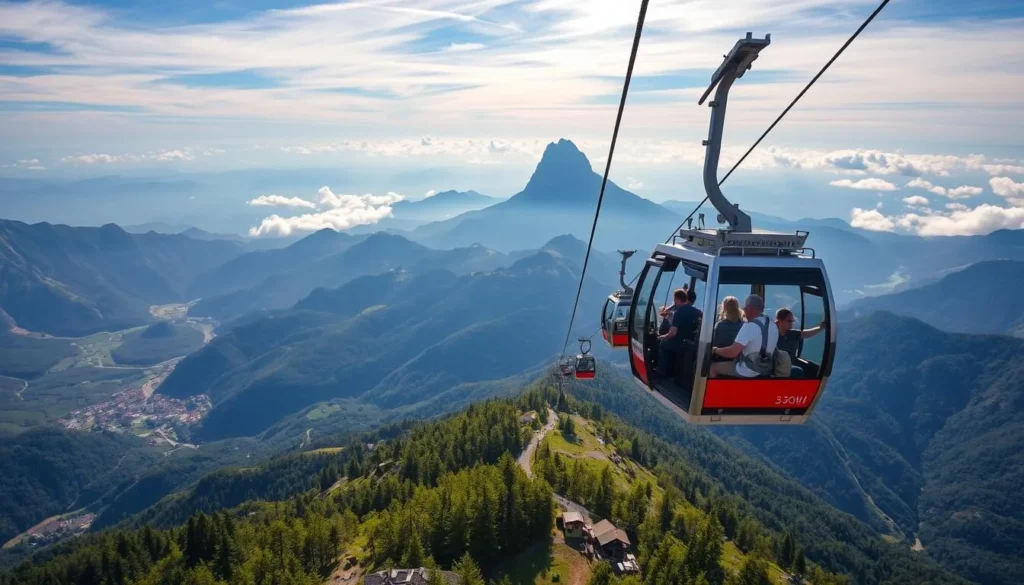
As you ascend to new heights via the cable cars around Dom, the panoramic views of the Swiss Alps unfold in all their glory. The cable car network offers some of the most spectacular mountain experiences in Switzerland.
The Mittelallalin Cable Car Journey
The Mittelallalin cable car journey is a highlight, whisking visitors up to 3,500 meters for breathtaking views of Dom and over 20 surrounding peaks. At the Mittelallalin station, you can visit the world’s highest revolving restaurant, which completes a full rotation every hour.
This unique dining experience allows you to enjoy 360-degree panoramic views of the alpine landscape while savoring Swiss culinary specialties. The Mittelallalin cable car is part of a comprehensive tour that showcases the beauty of the Swiss Alps.
Metro Alpin: The World’s Highest Subway
The Metro Alpin is recognized as the world’s highest subway, tunneling through the mountain to reach Mittelallalin. This unique underground journey contrasts dramatically with the expansive views waiting at the top.
For those interested in a comprehensive tour of the area, the Metro Alpin provides an exciting experience, combining underground travel with breathtaking mountain vistas.
Hannig Cable Car for Panoramic Views
The Hannig Cable Car provides a more accessible ascent to 2,350 meters, where you can enjoy panoramic views from comfortable viewing platforms and mountain restaurants with sunny terraces.
This cable car is ideal for families or those looking for a more leisurely mountain experience. It offers a great way to tour the area without needing extensive hiking gear or technical climbing skills.
These cable car experiences make the majesty of Dom accessible to visitors of all ages and physical abilities, allowing everyone to experience the awe-inspiring beauty of the high alpine environment.
Alpine Flora and Fauna Around Dom
Dom, Switzerland, boasts an alpine ecosystem that is both resilient and diverse, offering a haven for rare species. The Swiss Alps surrounding Dom are characterized by extreme conditions, including high altitudes and low temperatures, yet this region supports a wide range of flora and fauna adapted to these harsh environments.
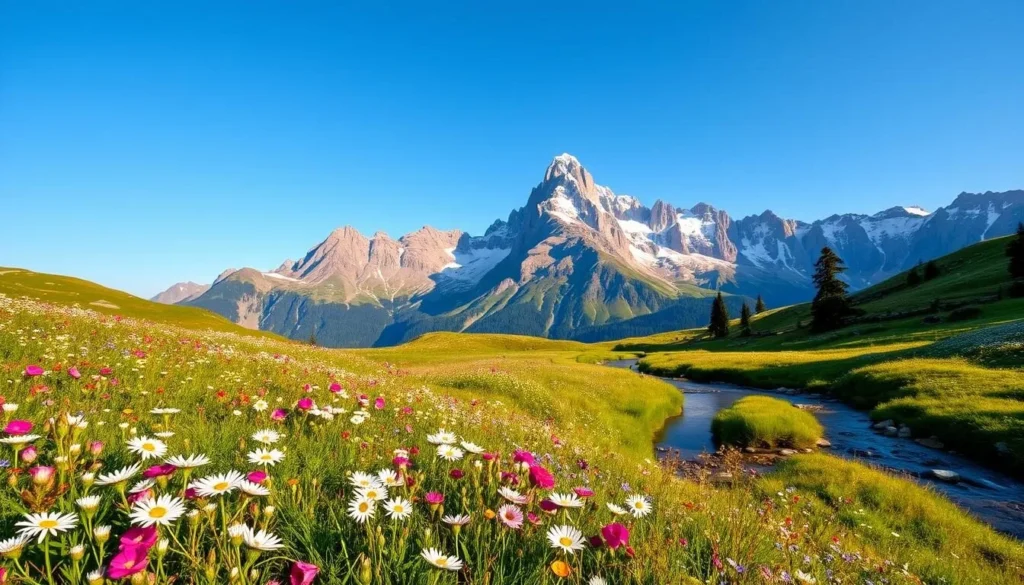
Rare Alpine Plants on Dom Mountain
The mountain slopes around Dom are home to several rare alpine plants that have adapted to survive in extreme conditions. One such plant is the purple saxifrage, found on the summit of Dom, one of the coldest places in Europe where a flowering plant has been recorded. This hardy species thrives despite nightly freezing temperatures, showcasing its remarkable resilience.
As spring arrives, the alpine meadows transform into a vibrant carpet of wildflowers, including rare species like edelweiss, gentians, and alpine roses. These plants have developed specialized features such as fuzzy coverings and compact growth patterns to survive the harsh alpine environment.
Wildlife Conservation in the Swiss Alps
The area around Dom is not only a haven for rare plants but also supports a diverse range of wildlife. Visitors can spot chamois and ibex navigating steep rocky terrain, marmots whistling warnings from their burrows, and golden eagles soaring on thermal currents above the mountain. Conservation efforts are in place to protect these species and their habitats from the impacts of climate change and tourism.
Several protected zones have been established to preserve biodiversity in the region. These conservation initiatives are crucial for maintaining the delicate balance of the alpine ecosystem and ensuring the long-term survival of the unique flora and fauna found in this beauty of a region.
Seasonal Changes in the Alpine Ecosystem
The alpine ecosystem around Dom undergoes dramatic seasonal changes. During the brief summer, there’s an explosion of plant life, while in winter, many species hibernate or migrate to lower elevations. Guided nature walks with local biologists offer insights into these adaptations and how they are being affected by warming temperatures.
As you explore this unique place, you’ll gain a deeper appreciation for the resilience of alpine flora and fauna and the importance of conservation efforts in preserving this remarkable ecosystem.
Photography Guide: Capturing Dom’s Majesty
With its distinctive pyramidal shape, Dom presents a photogenic challenge that attracts photographers from around the world. Capturing the essence of this majestic mountain requires a combination of technical skill, patience, and an understanding of the best times and places to shoot.
![]()
Best Viewpoints for Dom Photography
Finding the right vantage point is crucial for capturing stunning images of Dom. The Hohsaas viewing platform, situated at 3,142 meters, offers an unobstructed view of Dom’s profile against the backdrop of surrounding peaks. Another excellent spot is the Mattmark reservoir, where the still waters provide perfect reflections of Dom’s imposing north face on calm mornings.
For a different perspective, consider visiting the Kreuzboden area, which offers west-facing views ideal for capturing Dom bathed in the warm golden light of sunset. The silhouetted pine trees in the foreground add depth to your compositions, making for a compelling photograph.
Sunrise and Sunset Photography Tips
Photographing Dom during the golden hours of sunrise and sunset can yield breathtaking results. At sunrise, the alpenglow phenomenon paints the snow-covered summit in vibrant hues before the sun appears on the horizon. To capture this moment, arrive early and be prepared to shoot as the light changes.
For sunset shots, the Kreuzboden area is again an excellent choice, offering views of Dom bathed in the warm light of evening. Use a graduated neutral density filter to balance the bright mountain tops with the darker foreground, enhancing the overall dynamic range of your image.
Camera Settings for Alpine Photography
When photographing in the alpine environment, it’s essential to use the right camera settings to capture the beauty of Dom. A small aperture (f/8-f/11) ensures maximum depth of field, keeping the mountain and foreground in sharp focus. Use ISO 100-400 for optimal image quality, and don’t forget a sturdy tripod to stabilize your camera in the changing mountain light conditions.
Additionally, consider using a polarizing filter to reduce glare from snow and enhance the deep blue of the mountain sky. These simple adjustments can significantly improve the quality of your photographs, making them truly memorable.
Day Trips from Dom Region
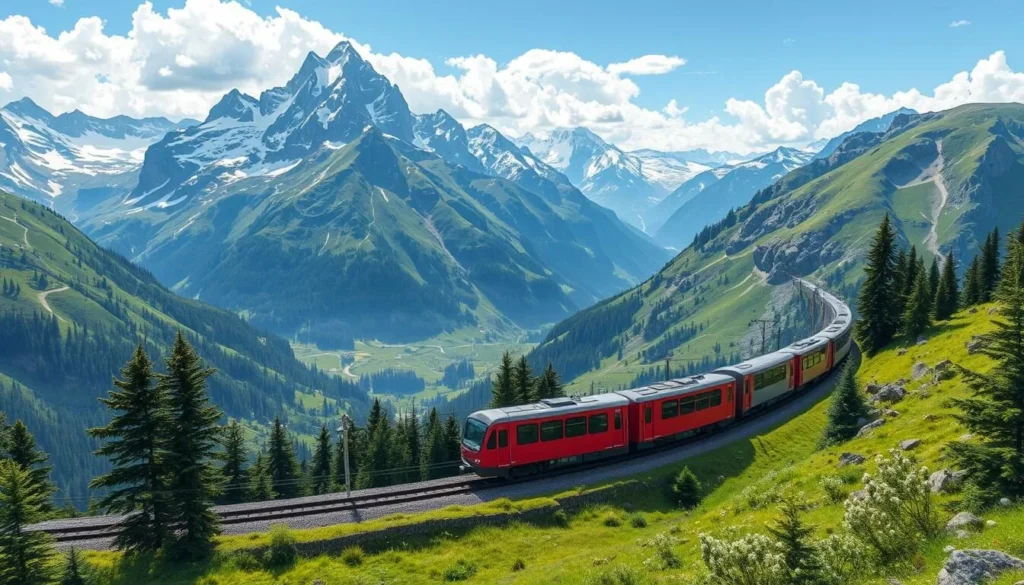
With its strategic location, the Dom region offers easy access to some of Switzerland’s most breathtaking destinations. You can explore charming villages, witness majestic mountains, and experience the rich cultural heritage of the Swiss Alps.
Visiting Zermatt and the Matterhorn
A day trip to Zermatt is a must when visiting the Dom region. This charming car-free village is famous for its ski resorts and offers breathtaking views of the iconic Matterhorn. You can explore the village, visit the Matterhorn Museum to learn about its rich mountaineering history, and enjoy various outdoor activities such as skiing and hiking.
The journey to Zermatt from Dom is approximately 90 minutes via the efficient Swiss transportation system, making it an ideal day trip destination.
Exploring the Aletsch Glacier
The magnificent Aletsch Glacier, a UNESCO World Heritage site, is another fantastic day trip option from the Dom region. As the largest glacier in the Alps, it stretches over 23 kilometers and offers a unique opportunity to witness the natural beauty of the Swiss Alps up close.
You can take a guided tour to explore the glacier and learn about its geological significance, or simply enjoy the breathtaking views from various viewpoints.
Trips to Nearby Swiss Villages
The Dom region is surrounded by charming Swiss villages that are perfect for half-day trips. Villages like Grächen, Stalden, and Visperterminen offer unique cultural experiences, local specialties, and breathtaking views.
For instance, Visperterminen is known for its high-altitude vineyards, which are among the highest in Europe. You can taste local wines and enjoy the picturesque scenery.
When planning your day trips from the Dom region, it’s advisable to start early to maximize your time at each destination. Consider purchasing regional transportation passes that offer unlimited travel and discounts on attractions, making your trip more convenient and cost-effective.
Culinary Experiences in the Dom Region
In the Dom region, traditional Swiss Alpine cuisine is more than just a meal; it’s an experience that warms the heart and nourishes the soul. As you explore the area, you’ll discover a rich culinary heritage shaped by the region’s agricultural practices and mountainous terrain.

Traditional Swiss Alpine Cuisine
Swiss Alpine cuisine is known for its hearty dishes, designed to sustain mountain dwellers through harsh winters. Cheese fondue, a quintessential Swiss dish, is made with melted Gruyère and Emmental cheese, white wine, and kirsch. It’s a communal dining experience that’s perfect for sharing with family and friends.
Raclette is another favorite, where melted cheese is scraped over potatoes, pickles, and cured meats, creating a hearty and communal feast. These cheese specialties dominate the local menu, reflecting the region’s agricultural heritage.
Mountain Restaurants with Views of Dom
Mountain restaurants around Dom offer not only delicious cuisine but also views that are simply breathtaking. The revolving restaurant at Mittelallalin is a prime example, where you can enjoy traditional rösti (Swiss potato fritters) while watching the panorama of peaks slowly circle around you.
These restaurants combine spectacular views with excellent cuisine, making dining an unforgettable experience.
Local Specialties and Delicacies
The Dom region is renowned for its local specialties, including Bündnerfleisch (air-dried beef) produced using traditional methods and alpine cheese made from the milk of cows grazing on herb-rich mountain pastures.
The region’s desserts showcase Swiss chocolate craftsmanship through creations like chocolate fondue and nusstorte (nut tart). Fruit-based treats like apple strudel reflect the influence of neighboring alpine cultures, adding to the region’s rich culinary culture.
Visitors can indulge in these local delicacies at various restaurants and cafes throughout the region, making the Dom region a culinary place to remember.
Family-Friendly Activities Near Dom
In the heart of the Swiss Alps, the Dom region stands out as a premier location for family-friendly adventures and experiences. You can enjoy a variety of activities that cater to all ages, making it an ideal destination for your next family vacation.

Kid-Friendly Hiking Trails
The Dom region offers several kid-friendly hiking trails that are designed to keep your little ones engaged and entertained. For instance, the Fairy Tale Path in Saas-Fee is a specially designed trail with storytelling panels and interactive elements that make the journey enjoyable for young hikers.
The Hohsaas Children’s Adventure Trail is another great option, featuring child-sized climbing elements, balance beams, and educational stations about alpine wildlife. This trail is set against the backdrop of Dom’s impressive north face, providing a perfect family day out.
Adventure Parks and Playgrounds
For families seeking more adrenaline-pumping activities, Saas-Fee’s Adventure Forest is a must-visit. It combines the thrill of a high ropes course with age-appropriate challenges for children as young as four. Additionally, the nearby summer toboggan run provides excitement for the whole family, regardless of athletic ability.
These adventure parks are designed to provide a fun and safe environment for children to explore and challenge themselves, making for a memorable experience in the Dom region.
Educational Nature Experiences
The Dom region is not just about adventure; it also offers several educational nature experiences that are perfect for families. Guided marmot watching tours allow children to observe these charismatic alpine animals in their natural habitat, learning about their behavior and the ecosystem they inhabit.
The Alpine Zoo in Saas-Fee is another educational attraction, housing rescued wildlife that cannot return to the wild. The zoo offers close encounters with alpine species and daily feeding sessions where naturalists explain the animals’ roles in the mountain ecosystem.
For rainy days, the Saas-Fee Glacier World exhibition provides an interactive learning experience about glaciers, climate change, and alpine environments, with hands-on exhibits designed to engage children’s curiosity about the natural world.
Cultural and Historical Sites in the Dom Region
As you explore the Dom region, you’ll discover a rich tapestry of cultural and historical sites that reflect the area’s unique heritage. The region’s strategic location near the Italian-Austrian border has contributed to its diverse history, including significant events from World War I.
Alpine Museums and Heritage Centers
The Dom region is home to several museums that preserve and showcase its cultural heritage. The Saaser Museum in Saas-Fee is a prime example, documenting the transformation of the area from isolated farming communities to a renowned mountain destination. Visitors can explore artifacts, photographs, and multimedia exhibits that tell the story of the region’s development.
The museum offers insights into the lives of the local people, their traditions, and the challenges they faced. By visiting these museums, you can gain a deeper understanding of the region’s history and culture.
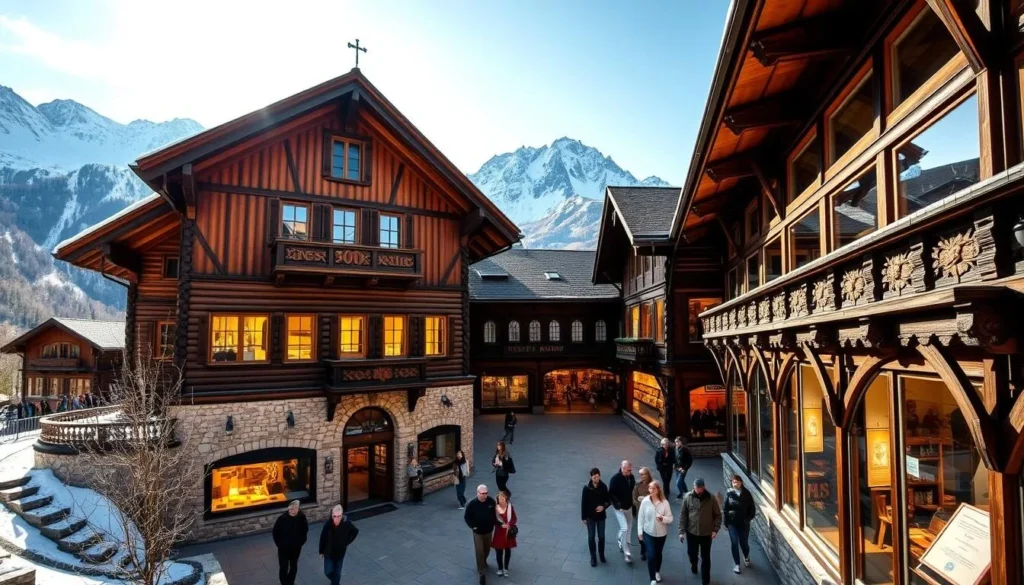
Religious Monuments and Churches
The Dom region is dotted with religious monuments and churches that reflect the deep Catholic traditions of the area. The Parish Church of St. Joseph in Saas-Grund is notable for its beautiful baroque architecture, while the Chapel of the Holy Spirit in Saas-Almagell contains valuable 17th-century religious art.
The Kapellenweg, or Chapel Trail, is a historical pilgrimage route that connects 15 small chapels built between the 17th and 19th centuries. Each chapel depicts scenes from the life of Christ, creating a spiritual journey through the picturesque Alpine landscape.
| Location | Religious Monument | Description |
|---|---|---|
| Saas-Grund | Parish Church of St. Joseph | Baroque architecture |
| Saas-Almagell | Chapel of the Holy Spirit | 17th-century religious art |
| Saas Valley | Kapellenweg (Chapel Trail) | 15 chapels depicting scenes from the life of Christ |
Traditional Alpine Festivals and Events
The Dom region celebrates various traditional Alpine festivals throughout the year. The Alpabzug, or cow descent, in September is a highlight, where decorated cattle return from summer pastures. Additionally, the Corpus Christi processions feature locals wearing traditional costumes and carrying religious symbols through village streets.
Cultural demonstrations of traditional crafts, such as wood carving, cheese making, and alphorn playing, are regularly scheduled in villages throughout the region. These events offer visitors a unique glimpse into Alpine traditions that have been maintained for generations.
- Alpabzug (Cow Descent) in September
- Corpus Christi processions
- Cultural demonstrations of traditional crafts
By experiencing these cultural and historical sites, you’ll gain a deeper appreciation for the Dom region’s rich heritage and the traditions that continue to thrive in this beautiful Alpine setting.
Sustainable Tourism Practices When Visiting Dom
Sustainable tourism practices are crucial when visiting Dom, ensuring that this stunning Swiss Alps destination remains unspoiled for future generations. As you explore the region, you’ll discover that preserving its natural beauty is a collective effort involving local communities, conservation organizations, and visitors like you.
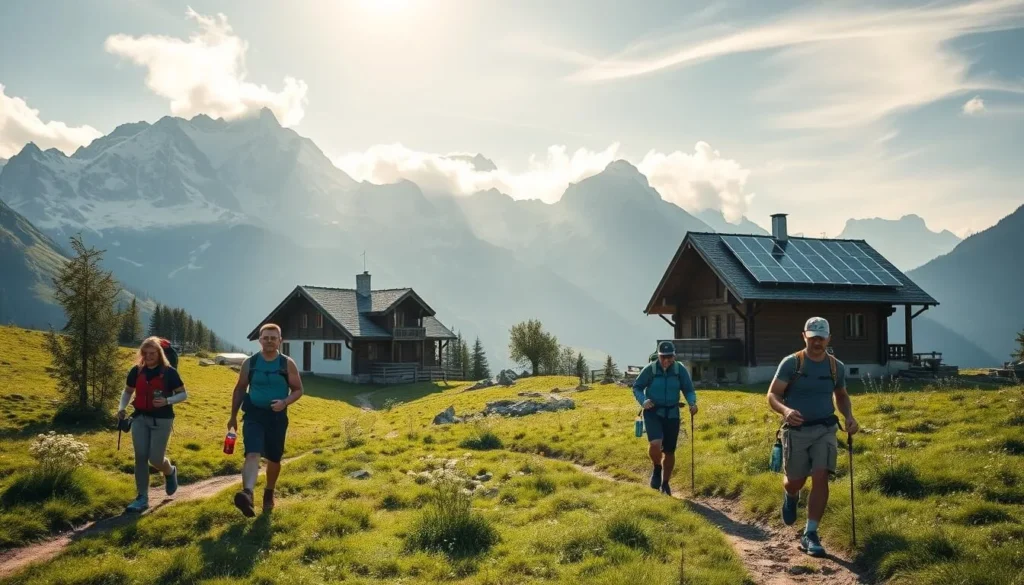
Eco-Friendly Transportation Options
The Dom region has embraced sustainable tourism as essential for preserving its natural beauty. One of the ways you can contribute is by using eco-friendly transportation options. For instance, villages like Saas-Fee are car-free, relying on electric shuttle services for visitors and their luggage. Switzerland’s excellent public transportation network makes eco-friendly travel to and around the Dom region simple, with efficient train and bus connections that reduce carbon emissions while providing scenic journeys through the Swiss Alps.
- Use public transportation or shuttle services to reduce your carbon footprint.
- Consider renting an electric or hybrid vehicle if you prefer to drive.
- Take advantage of the region’s train and bus connections for scenic tours.
Responsible Hiking and Wildlife Viewing
Responsible hiking practices are actively promoted through visitor education programs in the Dom region. These programs emphasize the importance of staying on marked trails, properly disposing of waste, and respecting wildlife by maintaining appropriate distances and avoiding disruptive behavior. By following these guidelines, you can help preserve the region’s delicate ecosystems and enjoy a more authentic tour experience.
- Stay on designated trails to avoid damaging the environment.
- Dispose of waste properly to keep the region clean.
- Maintain a safe distance from wildlife to respect their habitat.
Supporting Local Conservation Efforts
Local conservation efforts in the Dom region include glacier monitoring programs, alpine habitat restoration projects, and wildlife corridors. You can learn about these initiatives through interpretive centers and guided tours led by conservation experts. Many accommodations and restaurants in the region have also committed to sustainability through practices like using locally-sourced food, implementing energy-efficient systems, and reducing single-use plastics.
- Choose accommodations and restaurants that prioritize sustainability.
- Participate in guided tours that support conservation efforts.
- Learn about local conservation initiatives through interpretive centers.
By adopting these sustainable tourism practices, you can ensure that your visit to Dom supports the long-term preservation of its natural and cultural heritage. Remember, every tour decision you make can have a positive impact on this beautiful region.
Practical Tips for Your Dom Adventure
As you prepare for your adventure in the Swiss Alps, particularly around Dom, Switzerland, it’s essential to consider several practical tips to ensure a smooth and enjoyable trip. Your experience in this majestic region can be significantly enhanced by being well-prepared.

Safety Considerations for Alpine Exploration
Safety should be your top priority when exploring the Alpine environment around Dom. The weather conditions in this region can change rapidly, even during the summer months. It’s crucial to check the weather forecasts before heading out and be prepared to adjust your plans if conditions deteriorate.
- Acclimatize gradually to higher elevations to reduce the risk of altitude sickness.
- Stay hydrated by drinking plenty of water throughout your hike or tour.
- Apply sunscreen regularly, as UV radiation increases by approximately 10% with every 1,000 meters of elevation.
- Carry a basic first aid kit on all your excursions.
By taking these precautions, you can significantly reduce the risks associated with Alpine exploration and enjoy your adventure with peace of mind.
Packing Essentials for the Dom Region
Packing the right gear is vital for a comfortable and enjoyable trip to the Dom region. Some of the essential items to include in your luggage are:
- Layered clothing to adjust to changing temperatures.
- Quality hiking boots with ankle support for stability on rugged trails.
- A waterproof jacket to protect against unexpected rain or snow.
- Sun protection, including sunscreen, sunglasses, and a hat.
- A refillable water bottle to stay hydrated.
By packing these essentials, you’ll be well-prepared for the varying conditions you may encounter in the Dom region.
Budget Planning for Your Swiss Alps Trip
Switzerland is known for being an expensive destination, but there are ways to manage your expenses and stay within your budget. Consider the following tips to save money on your trip:
- Book your accommodations in advance to secure better rates.
- Purchase regional transportation passes for cost-effective travel.
- Pack lunches for your day trips instead of eating out.
- Take advantage of free or low-cost activities, such as self-guided hiking.
The Swiss Travel Pass is an excellent option for visitors planning to use public transportation extensively. It offers free admission to many museums and discounts on mountain lifts throughout the Swiss Alps, providing great value for your money.
By being mindful of your expenses and making a few smart choices, you can enjoy your trip to the Swiss Alps without breaking the bank.
Conclusion: The Timeless Appeal of Dom, Switzerland
Dom, a monumental figure in the Swiss Alps, stands as a testament to the region’s unspoiled beauty and rich cultural heritage. As you’ve explored in this article, the area around Dom offers a diverse range of experiences that cater to all kinds of travelers, from adventure seekers to those looking for a serene escape amidst nature.
The Swiss Alps, with Dom as a central highlight, provide breathtaking views and scenery that are simply unmatched. Whether you’re hiking through lush meadows in the summer or enjoying the snow-covered landscapes in winter, each season brings its unique charm to the region.
One of the key aspects that make Dom truly special is its perfect balance between accessibility and wilderness. Visitors can enjoy the comfort and charm of well-developed tourism infrastructure while still experiencing the raw power and majesty of the mountains.
Beyond its natural beauty, the Dom region is also rich in culture and history. The local villages, such as Saas-Fee, offer a glimpse into traditional Alpine life, with their historic attractions, local cuisine, and cultural events.
As you plan your trip to the Swiss Alps, remember that Dom is more than just a destination on your itinerary. It’s a place where you can slow down, connect with nature’s grandeur, and perhaps discover something new about yourself. Whether you’re marveling at the peaks, enjoying local chocolate in a cozy mountain restaurant, or hiking through meadows filled with wildflowers, the memories you create here will be truly unforgettable.
The Swiss Alps, with Dom at their heart, are a destination that promises an enriching experience. With its unique blend of natural beauty, culture, and adventure, Dom is a place that will leave a lasting impression on your heart.
In conclusion, Dom, Switzerland, is a timeless gem in the Swiss Alps, offering a rich tapestry of experiences that will captivate your senses and nourish your soul. As you leave Dom and return home, the views, the scenery, and the warmth of the local culture will stay with you, beckoning you to return and explore more of what this incredible region has to offer.
The above is subject to change.
Check back often to TRAVEL.COM for the latest travel tips and deals.
